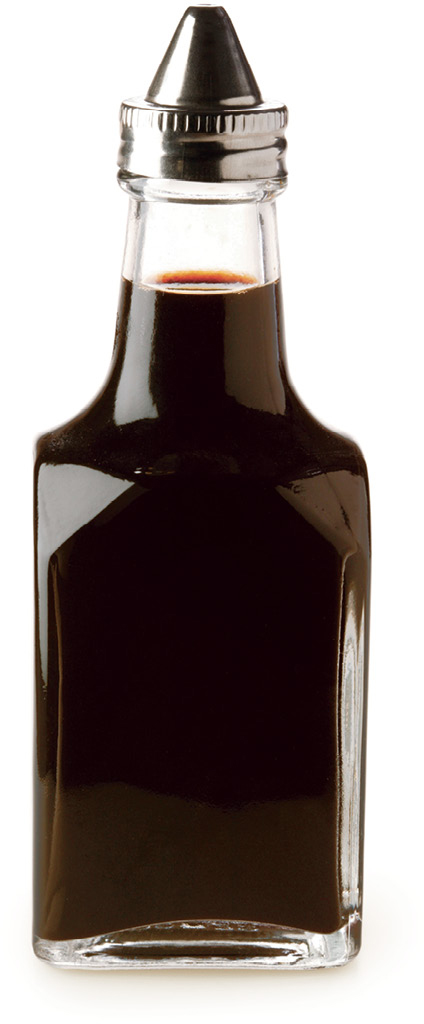
VERY LOW
Fans of folk medicine swear by vinegar to treat just about anything that could ail a person, from sunburns to stomachaches to dull hair. But there’s one truly effective use for vinegar that most people don’t know about. It turns out that simply adding a high-acid food like vinegar to your meals can reduce the blood sugar effect of the entire meal—by 19 to 55 percent!
In one small Italian study, when five people consumed 1 gram of acetic acid (the equivalent of 1 1/3 tablespoons of vinegar) and olive oil (sounds suspiciously like a vinaigrette salad dressing!), followed by 50 grams of carbohydrates from white bread (the amount in about four small slices), their blood sugar went up 31 percent less than when they ate just the bread.
In another study, this one from Arizona State University, when healthy people consumed about 4 teaspoons of cider vinegar before eating a high-GI meal (a bagel, butter, and orange juice), their blood sugar rose an average of 55 percent less after an hour than when they drank water sweetened with saccharin before the meal. And in another study by the same researchers, people with insulin resistance who consumed vinegar before a bagel meal had a 34 percent increase, on average, in insulin sensitivity—which of course translates to better blood sugar control.
Yet another study, this one from Japan, found that when vinegar was part of a meal, it reduced the glycemic index of white rice by an impressive 20 to 40 percent.
One reason for the dramatic findings: The acid in vinegar slows the rate at which food leaves your stomach, also slowing the transformation of a meal’s carbohydrates into blood sugar. Animal studies also suggest the acid may help increase the storage of glycogen (the form in which blood sugar is stored for future energy needs) in the liver and skeletal muscles, getting it out of the bloodstream.
Some of the same research that shows vinegar can lower blood sugar also shows that it can make you feel more satisfied after a meal—a boon to anyone trying to lose weight. Vinegar also fights bacteria and fungi, which is why it’s used in some homemade preparations for swimmer’s ear.

Don’t limit yourself to plain ol’ distilled vinegar. Try red or white wine vinegar, rice vinegar, or apple cider vinegar. Or buy or make flavor-infused vinegars such as tarragon, raspberry, strawberry, and so on. See “Pump Up the Flavor” to learn how to make your own flavored vinegar.
 Start dinner with a spinach salad dressed with balsamic vinegar and oil.
Start dinner with a spinach salad dressed with balsamic vinegar and oil.
 Mix up Asian coleslaw with shredded red cabbage and carrots, mung bean sprouts, chopped bok choy, olive oil, rice vinegar, sesame seed oil, chopped cilantro, and toasted sesame seeds.
Mix up Asian coleslaw with shredded red cabbage and carrots, mung bean sprouts, chopped bok choy, olive oil, rice vinegar, sesame seed oil, chopped cilantro, and toasted sesame seeds.
 Marinate sliced beets in balsamic vinegar, rosemary, crushed garlic, and herbes de Provence for about 20 minutes. Place the beets and marinade in a foil packet, seal tightly, and grill until tender.
Marinate sliced beets in balsamic vinegar, rosemary, crushed garlic, and herbes de Provence for about 20 minutes. Place the beets and marinade in a foil packet, seal tightly, and grill until tender.
 Make a balsamic vinegar glaze for grilled salmon. In a saucepan, boil balsamic vinegar, red wine, and a bit of honey until thick. Serve over the salmon.
Make a balsamic vinegar glaze for grilled salmon. In a saucepan, boil balsamic vinegar, red wine, and a bit of honey until thick. Serve over the salmon.
 Marinate chicken in cider vinegar and canola oil before baking or grilling.
Marinate chicken in cider vinegar and canola oil before baking or grilling.
 Serve soy-glazed chicken. In a skillet, sauté chopped garlic and shallots in olive oil, then add chopped tomato, distilled vinegar, soy sauce, honey, salt, and pepper. Stir well. Add cooked chicken breast and cook over medium-high heat, turning occasionally, until the vinegar mixture has thickened into a glaze.
Serve soy-glazed chicken. In a skillet, sauté chopped garlic and shallots in olive oil, then add chopped tomato, distilled vinegar, soy sauce, honey, salt, and pepper. Stir well. Add cooked chicken breast and cook over medium-high heat, turning occasionally, until the vinegar mixture has thickened into a glaze.
 Pickle some carrots. In a medium saucepan, mix 1 cup distilled white vinegar, 2 tablespoons sugar, 1 teaspoon salt, pepper to taste, and 2/3 cup water. Bring to a boil, then remove from the heat and let cool slightly. Dice eight large carrots, place in sterile containers, and cover with the vinegar solution. Seal and refrigerate for 12 hours or overnight.
Pickle some carrots. In a medium saucepan, mix 1 cup distilled white vinegar, 2 tablespoons sugar, 1 teaspoon salt, pepper to taste, and 2/3 cup water. Bring to a boil, then remove from the heat and let cool slightly. Dice eight large carrots, place in sterile containers, and cover with the vinegar solution. Seal and refrigerate for 12 hours or overnight.
 For dessert, serve sliced strawberries splashed with balsamic vinegar and sprinkled with a few pinches of sugar.
For dessert, serve sliced strawberries splashed with balsamic vinegar and sprinkled with a few pinches of sugar.
Flank Steak with Balsamic Sauce
Lentils with Peaches and Currants
Sautéed Brussels Sprouts with Red Pepper and Caraway Seeds